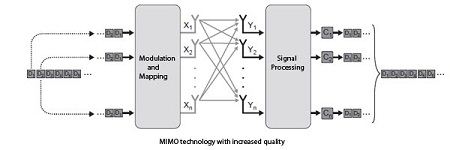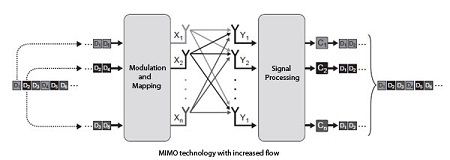MIMO technology (Multiple Input Multiple Output) is not new, but it hits the market that at the end of the first decade of the 2000s due to a very complex implementation. MIMO aims to carry multiple streams in parallel on different antennas but using the same frequency.
The idea is to connect multiple antennas at the transmitter, which transmit different flows on the same frequency. Due to the properties of multipath found in environments with obstacles, the signals arrive at different times at the receiver. If the receiver is powerful enough, it is able to decrypt the binary sequences arriving at different times. Note that the MIMO technique is satisfactory only in sets disturbed with obstacles and to avoid using it outside of buildings.
The MIMO operation diagram is shown in Figure, assuming n transmitters and receiver’s n. MIMO can operate with only one receiving antenna, but with the risk of not recovering all signals. In this figure, the same bit sequence is transmitted over all antennas. The objective is to increase the quality of transmission since the receiver receives the same bit multiple times and chooses the value of most strongly received. It should in this case be an odd number of antennas to be sure to separate the bits received. Diversity expresses instead to increase the quality by increasing the number of times the same bit is transmitted, it can increase throughput by transmitting different bits. This second solution is illustrated in Figure.


 Dinesh Thakur holds an B.C.A, MCDBA, MCSD certifications. Dinesh authors the hugely popular
Dinesh Thakur holds an B.C.A, MCDBA, MCSD certifications. Dinesh authors the hugely popular